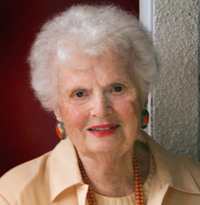By Natasha Josefowitz, ACSW, Ph.D.

LA JOLLA, California — A few days ago a friend came to visit me with her new puppy, a nine-month old mini-Australian shepherd. After the puppy finished exploring my apartment and drank some water, he jumped in my lap and licked my face; I was smitten. All my nurturing instincts reawakened. I wanted, needed a dog. Of course, at 95 any dog would become an orphan within a very few short years; not fair for the dog. No, I am not getting one.
What is interesting that during the pandemic animal rescue centers saw a surge of demands for adoptions. People were isolated and needed something to take care of, needed companionship. During that time there was also an increase of plant sales, again the need to take care of something alive. This caring propensity shows itself early, as early as early as four to six months of age in children. Children hug their stuffed animal and cry when separated from it. In 1995 Donald Winnicott introduced the term “transitional object” describing the intense attachment children develop to an object. This attachment, part of a healthy ego development, is necessary to differentiate self from others as well as an early phase of independence from parents. The child is learning to sooth him or herself by gaining emotional support from the stuffed animal. The toy industry recognizes this and provides clothes and furniture for dolls fulfilling the child’s need to care for an inanimate object, pretending it’s real. Stroking the soft fur, holding a stuffed animal close, and cuddling it can reduce the stress coming from facing an unfamiliar situation or an unfamiliar care taker. The sense of security provided by the stuffed animal cannot only soothe a child, but can give the child courage to face new situations.
Most people have personal possessions that are treasured and serve as extensions of oneself. These cherished possessions may be connected to memories of important events or have belonged to a well-l0ved person. This is why it is often hard for people to move from a familiar home to a smaller apartment or retirement community. This move entails loss of objects too large to take or too cumbersome to keep. Some people are able to easily discard some no longer used objects while others hold on to a variety of items that have no longer real use in their lives, only the memories attached to them.
Extreme object attachments may be a way to compensate for a lack of inter-personal attachments, or may be a symptom of a hoarding disorder. The diagnosis of hoarding disorder is based on the rating of intensity of emotions when imagining the loss of the object. In addition, the identity of the horded object may be significant. Holding on to years of old newspapers or discarded containers is different from holding on to a collection of travel postcards or ceramic figurines. As people age and experience physical, emotional, and cognitive changes, the attachment to objects also shifts. For some it intensifies; for others it is the reverse, they care for nothing any more.
Some people hold on to lucky charms or something hand-made that may have reflected a labor of love. Retaining golf clubs or a tennis racquet in old age may be a reminder of an active past life. It is also difficult for widows/widowers to discard objects worn by their deceased partner. I still have a teddy bear donning a Navy uniform reminding me of Herman serving in the Navy.
As people age, one factor in senility is the return to childhood including the need to hold on to a stuffed animal. Many caregivers have reported that giving their older patients a stuffed animal has increased calmness and reduced agitation and anxiety in these patients. There has been a positive impact in giving a robotic pet to dementia patients. The robotic pet can respond verbally to comments and questions. They bring comfort and lower stress in preventing loneliness. By allowing the seniors to interact with these robotic pets also reduces depression and improves socialization and communication.
It is interesting to note that the need to nurture, to care for something, the need for companionship does not lessen with age. Even in dementia the human propensity does not diminish. The results of this new field study provides innovative insights to help improve better mental health in our aging population.
*
© Natasha Josefowitz. This article appeared initially in the La Jolla Village News. You may comment to natasha.josefowitz@sdjewishworld.com